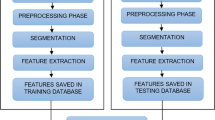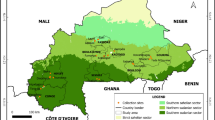Abstract
This study used quantitative descriptors to assess morphological variation of traditionally classified tamarind fruits and its relation to ecological conditions. Tamarind trees were sampled spanning locally recognized fruit morphotypes within three ecological zones. Twelve morphological descriptors were measured on 3000 fruits and seeds. Univariate and canonical discrimiant analyses performed on morphological descriptors revealed significant differences and confirmed morphotypes distinction as perceived by local people. Nevertheless, the variance components analysis showed substantial variations within morphotypes, suggesting a significant heterogeneity within fruits traditionally classified as belonging to the same morphotypes. To get a more powerful morphological discrimination, quantitative descriptors should hence be combined with locally perceived qualitative traits (pulp taste and colour). Observed variations were significantly correlated with ecological factors. Fruits’ and seeds’ size and mass tended to increase with humidity and decline with aridity. Results also indicated that fruit mass is a good predicator of pulp yield, although its predicting power differed among morphotypes. Outputs from the variance component analysis suggested that pending further genetic studies, germplasm collection should be done by sampling a moderate number of trees per morphotype, to ensure capturing a wide range of genetic diversity. The observed extensive variation has provided with relevant information for further improvement programs.

Similar content being viewed by others
References
Assogbadjo AE, Sinsin B, Van Damme P (2005) Caractères morphologiques et production des capsules de baobab (Adansonia digitata L.) au Bénin. Fruits 60(5):327–340
Assogbadjo AE, Kyndt T, Sinsin B, Gheysen G, Van Damme P (2006) Patterns of genetic and morphometric diversity in baobab (Adansonia digitata L.) populations across different climatic zones of Benin (West Africa). Ann Bot 97:819–830
Assogbadjo AE, Glèlè Kakaï R, Chadare FJ, Thomson L, Kyndt T, Sinsin B, Van Damme P (2008) Folk classification, perception and preferences of baobab products in West Africa: consequences for species conservation and improvement. Econ Bot 62(1):74–84
Assogbadjo AE, Kyndt T, Chadare FJ, Sinsin B, Gheysen G, Eyog-Matig O, Van Damme P (2009) Genetic fingerprinting using AFLP cannot distinguish traditionally classified baobab morphotypes. Agrofor Syst 75:157–165
Diallo BO, Joly HI, Mckey D, Hossaertmckey M, Chevallier MH (2007) Genetic diversity of Tamarindus indica populations: any clues on the origin from its current distribution? Afr J Biotechnol 6(7):853–860
Diallo BO, Mckey D, Chevallier M-H, Joly HI, Hossaert-Mckey M (2008) Breeding system and pollination biology of the semi-domesticated fruit tree, Tamarindus indica L. (Leguminosae: Caesalpinioideae): implications for fruit production, selective breeding, and conservation of genetic resources. Afr J Biotechnol 7(22):4068–4075
El-Siddig K, Gunasena HPM, Prasad BA, Pushpakumara DKNG, Ramana KVR, Vijayanand P, Williams JT (2006) Tamarind, Tamarindus indica L. Southampton Centre for Underutilised Crops, Southampton, UK
Eyog Matig O, Gaoué OG, Dossou B (2002) Réseaux “Espèces Ligneuses Alimentaire”. Compte rendu de la première réunion du Réseau tenue du 11–13 décembre 2000 au CNSF Ouagadougou, Burkina Faso 241: Institut International des Ressources Phytogénétiques
Fandohan AB, Assogbadjo AE, Glèlè RL, Sinsin B, Van Damme P (2010) Impact of habitat type on the conservation status of tamarind (Tamarindus indica L.) populations in the W National Park of Benin. Fruits 65:11–19. doi:10.1051/fruits/2009037
Goodnight JH (1978) Computing MIVQUE0 estimates of variance components, SAS technical report R-105. SAS Institute Inc, Cary, NC
Heaton HJ, Whitkus R, Gomez-Pompa A (1999) Extreme ecological and phenotypic differences in the tropical tree chicozapote (Manilkara zapota (L.) P. Royen) are not matched by genetic divergence: a random amplified polymorphic DNA (RAPD) analysis. Mol Ecol 8:627–632
Hijmans RJ, Cameron SE, Parra JL, Jones PG, Jarvis A (2004) The WorldClim interpolated global terrestrial climate surfaces. Version 1.3. http://biogeo.berkeley.edu
IBPGR (1980) Working group to review the tropical fruit descriptors and strategy for collection, evaluation, utilization and conservation. Bangkok. Thailand. 14–15 July
Khan ML (2004) Effects of seed mass on seedling success in Artocarpus heterophyllus L., a tropical tree species of North-East India. Acta Oecologica 25:103–110
Kouyaté AM, Van Damme P (2002) Caractères morphologiques de Detarium microcarpum Guill. et Perr. au sud du Mali. Fruits 57:231–238
Kutner HM, Nachtsheim JC, Neter J, Li W (2005) Applied linear statistical models, 5th edn. McGraw-Hill International, New York
Kyndt T, Assogbadjo AE, Hardy OJ, Glele Kakaï R, Sinsin B, Van Damme P, Gheysen G (2009) Spatial and temporal genetic structuring of Adansonia digitata L. (Malvaceae) in the traditional agroforestry systems of West Africa. Am J Bot 96(5):950–957
Leakey RRB (2005) Domestication potential of Marula (Sclerocarya birrea subsp. caffra) in South Africa and Namibia: 3. Multi-trait selection. Agrofor Syst 64:51–59
Leakey RRB, Page T (2006) The ‘ideotype concept’ and its application to the selection of ‘AFTP’ cultivars. Forest Trees Livelihood 16:5–16
Leakey RRB, Fondoun J-M, Atangana A, Tchoundjeu Z (2000) Quantitative descriptors of variation in the fruits and seeds of Irvingia gabonensis. Agrofor Syst 50:47–58
Leakey RRB, Schreckenberg K, Tchoundjeu Z (2003) The participatory domestication of West African indigenous fruits. Int Forest Rev 5:338–347
Leakey RRB, Tchoundjeu Z, Smith RI, Munro RC, Fondoun J-M, Kengue J, Anegbeh PO, Atangana AR, Waruhiu AN, Asaah E, Usoro C, Ukafor V (2004) Evidence that subsis-tence farmers have domesticated indigenous fruits Dacryodes edulis and Irvingia gabonensis in Cameroon and Nigeria. Agrofor Syst 60:101–111
Leakey RRB, Shackleton S, du Plessis P (2005a) Domestication potential of marula (Sclerocarya birrea subsp. caffra) in South Africa and Namibia: 1. Phenotypic variation in fruit traits. Agrofor Syst 64:25–35
Leakey RRB, Greenwell P, Hall MN, Atangana AR, Usoro C, Anegbeh PO, Fondoun J-M, Tchoundjeu Z (2005b) Domestication of Irvingia gabonensis: 4. Tree-to-tree variation in food-thickening properties and in fat and protein contents of dika nut. Food Chem 90:365–378
Leakey RRB, Tchoundjeu Z, Schreckenberg K, Simons AJ, Shackleton S, Mander M, Wynberg R, Shackleton C, Sullivan C (2007) Trees and markets for agroforestry tree products: targeting poverty reduction and enhanced livelihoods. In: Garrity D, Okono AM, Parrott S (eds) World agroforestry into the future. World Agroforestry Centre, Nairobi, pp 11–22
Leakey R, Fuller S, Treloar T, Stevenson L, Hunter D, Nevenimo T, Binifa J, Moxon J (2008) Characterization of tree-to-tree variation in morphological, nutritional and medicinal properties of Canarium indicum nuts. Agrofor Syst 73:77–87
Lowe A, Harris S, Ashton P (2004) Ecological genetics: design, analysis and application, 6th edn. Backwell, London, UK
Mangenot G (1951) Une formule simple permettant de caractériser les climats de l’Afrique Intertropicale dans leurs rapports avec la végétation. Revue Générale de Botanique 58:353
Quinn GP, Keough JM (2005) Experimental design and data analysis for biologists, 4th edn. Cambridge University Press, Cambridge
Sanou H, Picard N, Lovett PN, Dembélé M, Korbo A, Diarisso D, Bouvet J-M (2006) Phenotypic variation of agromorphological traits of the shea tree. Vitellaria paradoxa CF Gaertn., in Mali. Genet Resour Crop Evol 53:145–161
SAS Institute Inc (2003) SAS OnlineDoc® 9.1. SAS Institute Inc, Cary, NC
Schlichting CD, Pigliucci M (1998) Phenotypic evolution: a reaction norm perspective. Sinauer Associates, Massachusetts, USA
Soloviev P, Niang TD, Gaye A, Totte A (2004) Variabilité des caractères physico-chimiques des fruits de trois espèces ligneuses de cueillette récoltés au Sénégal: Adansonia digitata, Balanites aegyptiaca et Tamarindus indica. Fruits 59:109–119
Thimmaraju KR, Bhaskar V, Usha K (1989) Pollen-limited seed set in pods of tamarind (Tamarindus indica L.). Ann Forest Sci 46:56–59
White F (1983) The vegetation of Africa. UNESCO Paris, France. Nat Resour Res 20:1–356
Acknowledgments
This work is supported by Domestication and Development of Baobab and Tamarind (DADOBAT-EU funded project). We are particularly grateful to Orou G. Gaoue and Jean TC Codjia for guidance and comments on an earlier version. We are indebted to local women for their substantial contribution to this work especially during morphotypes identification. Elisabeth Agadja, Alice Bonou and Gbaguidi Marie-Ange are gratefully acknowledged for their advice and warm-hearted help without which we could not have made efficient surveys. We are indebted to anonymous reviewers whose comments have improved this paper.
Author information
Authors and Affiliations
Corresponding author
Rights and permissions
About this article
Cite this article
Fandohan, B., Assogbadjo, A.E., Glèlè Kakaï, R. et al. Quantitative morphological descriptors confirm traditionally classified morphotypes of Tamarindus indica L. fruits. Genet Resour Crop Evol 58, 299–309 (2011). https://doi.org/10.1007/s10722-010-9575-3
Received:
Accepted:
Published:
Issue Date:
DOI: https://doi.org/10.1007/s10722-010-9575-3




